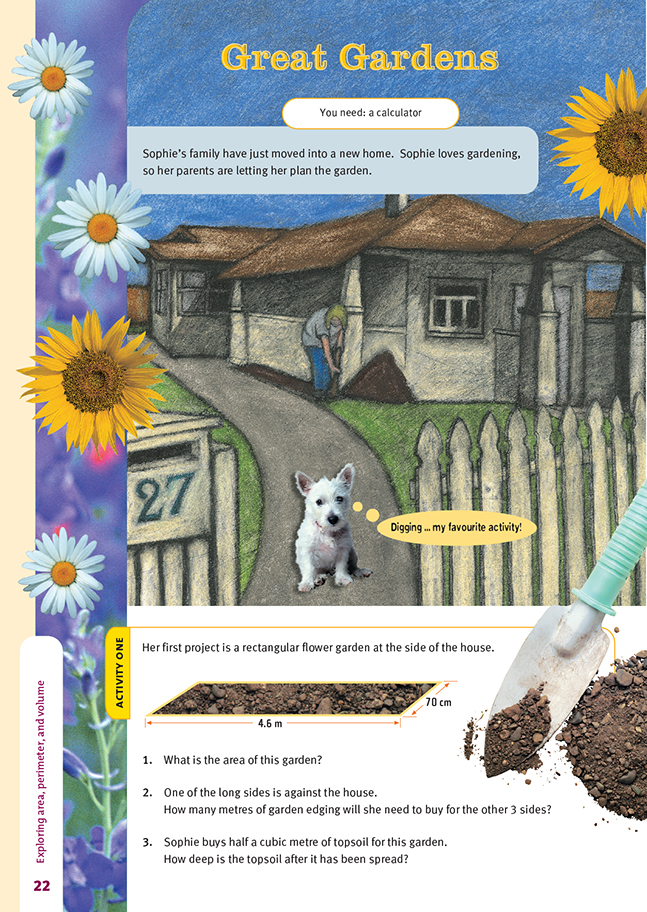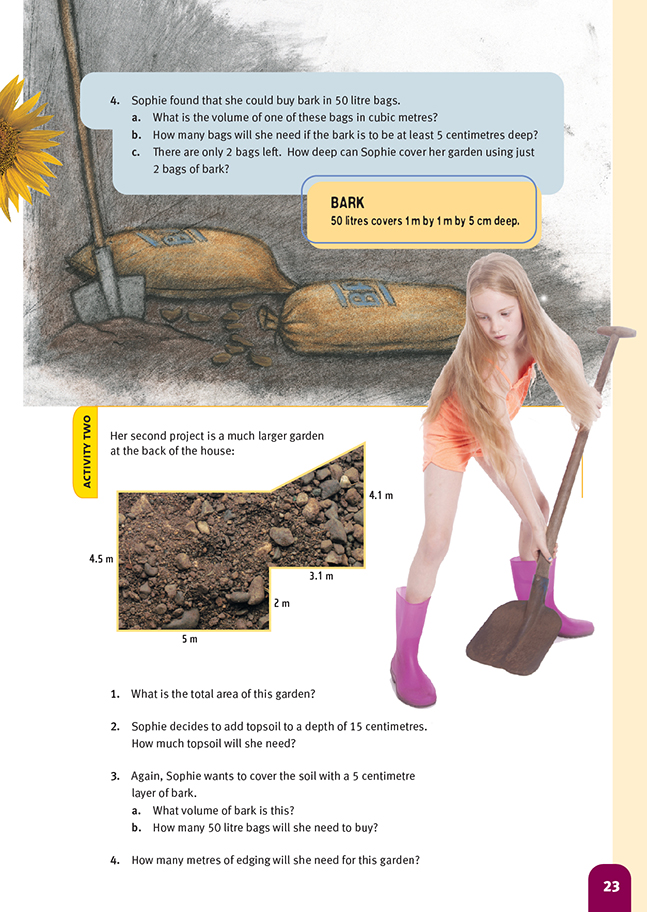This is a level 4 measurement strand activity from the Figure It Out series.
A PDF of the student activity is included.
Click on the image to enlarge it. Click again to close. Download PDF (456KB)
explore area, perimeter and volume
FIO, Level 4, Measurement, Book One, Great Gardens, pages 22-23
calculator
Activity One
The students should not have much trouble with the questions involving area and perimeter, though they may need help with those that involve depth. They do, however, need to note that measurements are given in centimetres and metres. In this context, metres are the most suitable units for length and square metres the most suitable units for area, but centimetres are fine for depth. Working between the different units will test their understanding of place value. Remind them that they must check their answers for reasonableness.
When doing question 3, the students could ask themselves how deep a cubic metre of soil would be when spread over 1 square metre, 2 square metres, or 3 square metres. They could then repeat the task, starting with half a cubic metre of soil. This should enable them to see the inverse relationship between area and depth (as area increases, depth decreases).
Question 4 requires students to convert litres into cubic metres. You may need to remind them that a cubic metre is the same as 1 000 litres.
Activity Two
This activity draws on similar maths, with the added complexity of a composite shape for area.
When doing question 4, the students will find that no length is given for the slant side of the garden. Instead of telling them how to deal with this, give them the chance to use the maths they know. It is not expected that they will use Pythagoras’ theorem; this is found in level 5 of the curriculum. Although it is not made explicit, the diagram of the garden has been drawn to scale. The students should be able to discover this
fact for themselves and to use the scale to find the length of the slant side accurate to the nearest 0.1 of a metre. If the diagram had not been drawn to scale, they could still have found the missing length to a sufficient level of accuracy by drawing it to scale themselves.
Cross-curricular links
Science
This activity could be linked to a science unit on horticulture. The students could investigate what mulches are, how they benefit the garden and the gardener, and what different kinds of mulch there are.
Achievement Objective
- investigate the positive and negative effects of substances on people and on the environment (Making Sense of the Material World, level 4)
Answers to Activities
Activity One
1. 3.22 m2. (4.6 x 0.7)
2. 6 m. (0.7 + 4.6 + 0.7)
3. 16 cm or between 15 and 16 cm (rounded from 15.53 cm). (Using centimetres, the volume of soil is 0.5 x 100 x 100 x 100 = 500 000 cm3, and the area of the garden is 460 x 70 = 32 200 cm3.
The depth is the volume of soil divided by the area it has to cover: 500 000 ÷ 32 200 = 15.53 cm.)
4. a. 0.05 m3.
b. 4 bags.
(The volume required to cover the garden to a depth of 5 cm is found by multiplying the area of the garden by 5: 32 200 x 5 = 161 000 cm3. Because 1 000 cm3 = 1 L, 161 000 cm3 = 161 L. 3 bags hold only 150 L, so 4 bags are needed.)
c. 3 cm.
(Two 50 L bags contain 100 L of bark. This is 100 000 cm3. Spread over an area of 32 200 cm2, this gives a depth of 100 000 ÷ 32 200 = 3.11 cm.)
Activity Two
1. 32.73 m2.
(5 x 4.5 + 3.1 x 2.5 + 0.5 x 3.1 x 1.6)
2. 4.91 m3. (The volume needed is found by multiplying the area of the garden by the depth of soil. Working in metres because of the larger area, 32.73 x 0.15 = 4.91m3, rounded to 3 significant figures.)
3. a. 1.64 m3
(Volume = 32.73 x 0.05 = 1.64 m3, rounded to 3 significant figures.)
b. 33.
(Number of bags = 1.64 ÷ 0.05 = 32.8)
4. 27.2 m

